5/1/2023
Inside Indoor Ag-Con
Jennifer Polanz
What a difference from five years ago—the last time I attended Indoor Ag-Con—to this year. The size of the trade show floor back then was a third of what it was this year, with more than 130 companies exhibiting in 174 booths. That’s double the amount of booths from last year, too.
The attendees responded, flocking to the show from 48 states in the U.S. (plus D.C. and U.S. territories), as well as from 29 other countries. All told, more than 1,450 people attended, a 62% increase over last year, according to the fine folks at Indoor Ag-Con. Then, add on about 200 more attendees from the co-located National Grocers Association Show.
“This tremendous response from the industry—particularly our growing international audience—positions Indoor Ag-Con as the global event for CEA and confirms the growing importance and potential of vertical farming and controlled environment agriculture,” said CEA Brian Sullivan in a recap released after the show.
Insights from the show
Some other aspects of the industry also became apparent to me at the show, both through listening to panel discussions and in my interactions on the trade show floor:
● The venture capital that’s been infused in the CEA industry up to this point is constricting. That’s leaving producers looking for other ways to fund their operations, hence Plenty’s announcement of partnering with a realty company, for example (more on that below).
● I anticipate more consolidation in the near future as we see operations with greater access to capital looking to scale up.
● More farms are moving out of the fact-finding phase and are starting to actively look for and invest in the systems they’ll use to build their farms.
● I’m hearing about more interest in diversifying product offerings to create more interest at retail. For example, in the session I moderated on creating the CEA category, Dave Vosburg, CIO for Local Bounti, talked about creating salad kits to set themselves apart and fill retail needs.
● There’s a lot of ag tech being developed out there, but it’s a challenge for farms to figure out how to incorporate them either into existing or new builds. Integrating five or six different technologies that don’t necessarily talk to each other or existing systems is a big undertaking and expensive.
● I still heard a lot of us versus them, whether it was vertical farms, greenhouse growers, container farms or field ag. There are a select few, however, beginning to work across methods to create hybrid operations.
More on Plenty
About a week before Indoor Ag-Con kicked off, the vertical farm Plenty Unlimited announced it entered into a strategic agreement with Realty Income Corporation that provides for up to $1 billion of development opportunities. I was able to sit down with Dan Malech, senior vice president of strategy and general counsel for Plenty, to find out what this means for the future of the business.
First, a refresher on Plenty, which has a vertical farm in Compton, California, to grow leafy greens, an R&D facility in Wyoming and a 120-acre farm campus with the first phase in progress near Richmond, Virginia.
Now, the relationship with Realty Income. “We’re taking the real estate portion of our farms—so that’s the land and building, and the big building systems that would be classified as real estate—and having those owned by our partner Realty Income and then leased to us so we pay rent as part of a long-term lease,” Dan explained. “One of the unique parts of the partnership with Realty Income is that starting with our next farm in Virginia, and then moving forward, we’re going to be doing custom builds for our farms.”
That means no more finding warehouses and retrofitting them. “There are some major efficiencies that we gain in doing that,” he added of the new, custom builds. It’s those efficiencies, in part, that the company expects to reduce the cost of production, along with proprietary breeding coming out of the R&D facility.
He further explained the benefits of funding the farms this way: “One of the advantages to doing it that way is the cost of capital. To date, pretty much everybody has been funding their development of their farms with venture capital, which is obviously more expensive than something like real estate financing.
“So we really view this as a big evolution in how these assets get funded going forward to cheaper and more infrastructure-like costs of capital versus pure venture, which frankly is not a scalable way to finance many of these facilities at an industrial scale.”
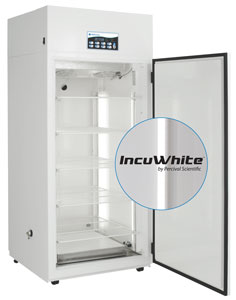
New products at the show
1. Percival Scientific, known for its growth chambers, has a new option for those interested in growing mushrooms. The Percival Model M-36VL with standard IncuWhite lighting is smaller and ideal for studying mushrooms or fungal biology, as well as growing small batches, and the features have been optimized for multiple types of fungi, molds and mushrooms.
I talked with Sales Manager Jamie Jackson at the show, and he said the company is seeing more interest in growing both culinary mushrooms and psychedelic mushrooms (right now only Colorado and Oregon have legalized them, but more states are investigating it), hence the new growth chamber. Mushrooms require low light and high humidity, and require CO2 removal—these chambers are equipped with the controls to provide the right environment for both mushroom inoculation and growing on to harvest. The company also offers a larger walk-in version of the chamber for those who need a bigger growing area.
Jamie noted the smaller chamber is basically plug-and-play after hooking up a water line for the humidifier, while the larger version has a little more to the install.
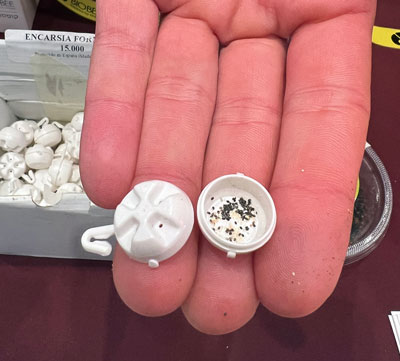 2. BioBee just introduced a new format for delivering the parasitic wasps Encarsia formosa and Eretmocerus eremicus to control whitefly in the greenhouse. These clever balls made of biodegradable plastic protect about 15,000 pupae as they’re hung in the plant canopy. The wasps can exit the balls through small holes to begin their hunting.
2. BioBee just introduced a new format for delivering the parasitic wasps Encarsia formosa and Eretmocerus eremicus to control whitefly in the greenhouse. These clever balls made of biodegradable plastic protect about 15,000 pupae as they’re hung in the plant canopy. The wasps can exit the balls through small holes to begin their hunting.
Kyle Miller, technical sales representative at BioBee, said the balls are in response to a problem they found growers having in deploying beneficial insects glued onto cards—workers were accidentally crushing them by gripping them where the pupae were glued. This way, the pupae are protected from workers and the elements.
Growers can get the balls with only one or the other wasp, depending on the type of whitefly they have. Or, if they have greenhouse and silverleaf whitefly, they can get a mix of both wasps. Kyle said, too, BioBee will work with the grower first to determine what type of outbreak they have to make sure they get the right wasps.
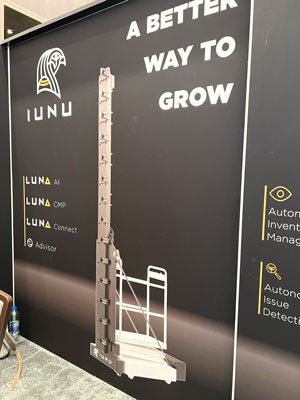 3. IUNU introduced its new Luna tomato imaging system with AI to monitor pests, track crop metrics and enable growers to forecast crops more accurately. The system has 14 cameras on a 10- to 14-ft. tall structure that fits onto a standard tomato production trolley.
3. IUNU introduced its new Luna tomato imaging system with AI to monitor pests, track crop metrics and enable growers to forecast crops more accurately. The system has 14 cameras on a 10- to 14-ft. tall structure that fits onto a standard tomato production trolley.
Workers can conduct their normal operations up and down the row while the Luna system works in the background. Growers pay for the hardware, then a monthly subscription service to receive the data. This is the second LUNA system IUNU has introduced—the first is an overhead imaging system for leafy greens production.
The nanobubble technology from 4. Moleaer isn’t necessarily new, but I wanted to point out some case studies the company has now highlighting the efficacy of the product. Here’s the definition of nanobubble from a case study on strawberry cultivation, in case you’re not familiar:
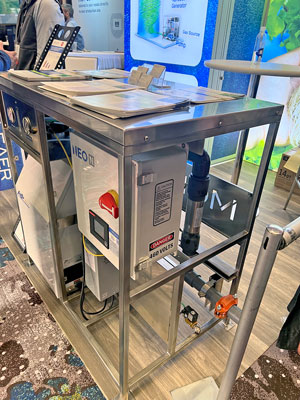 “Nanobubbles are tiny bubbles filled with air, oxygen or another gas. These nanobubbles are invisible to the naked eye and are 2,500 times smaller than a single grain of table salt.
“Nanobubbles are tiny bubbles filled with air, oxygen or another gas. These nanobubbles are invisible to the naked eye and are 2,500 times smaller than a single grain of table salt.
“At this size, bubbles exhibit extraordinary properties. For example, they no longer float to the surface and pop, instead they dissolve slowly and evenly throughout the entire body of water. Increased oxygen in the water and root zone allows for healthier root development, which leads to increased nutrient uptake.”
In that same case study, the research found a 14% yield increase and 74% lower Pythium counts in strawberry production. The nanobubble technology also serves as a mild oxidant, which means it can reduce pathogens, biofilms, algae, metals and other contaminants, according to the study.
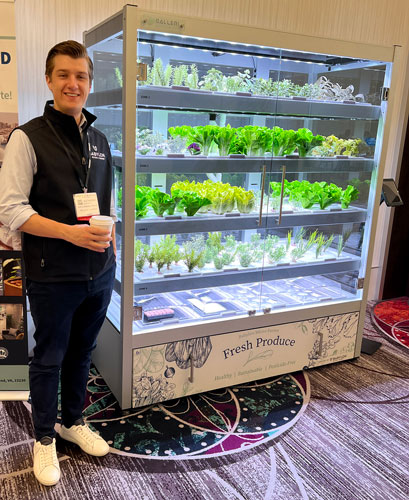 One of the members of the panel I moderated, Alexander Olesen, is the founder and CEO of 5. Babylon Micro-Farms, a hydroponic growing system that allows for growing fresh produce on-site at locations like cruise ships, long-term care facilities, universities, and other institutions and restaurants.
One of the members of the panel I moderated, Alexander Olesen, is the founder and CEO of 5. Babylon Micro-Farms, a hydroponic growing system that allows for growing fresh produce on-site at locations like cruise ships, long-term care facilities, universities, and other institutions and restaurants.
The best part for those who use it is they need very little experience, and the support team helps them with setup, growing and harvesting. It’s remotely monitored by the AI technology incorporated in the system. You can grow more than 45 different types of crops in it, and they’re grown via automated water management and nutrient dosing. The trays are dishwasher ready, too.